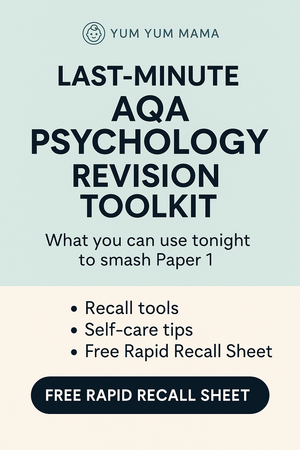Interactional Synchrony: A-Level Psychology Guide
What Is Interactional Synchrony?
Interactional synchrony refers to the coordinated, rhythmic exchange of signals—such as facial expressions, vocal tones, and gestures—between an infant and their caregiver. This mutual responsiveness is seen as a foundational component of early social development and attachment.
In simpler terms, it's when a baby and their caregiver respond to each other in a way that is emotionally connected and timed perfectly—like a silent, intuitive dance of connection.
What Does Interactional Synchrony Look Like?
Imagine a baby gurgling and a caregiver smiling in response, followed by the baby laughing as the caregiver imitates the sound. These small, moment-to-moment reactions create emotional harmony between the infant and caregiver.
This synchrony typically begins in the first few weeks of life and continues to play a critical role in the development of secure attachments.
Interactional Synchrony vs Reciprocity
While interactional synchrony focuses on simultaneous actions that are in rhythm with each other, reciprocity is more like a back-and-forth exchange—a ‘conversation’ of behaviours. For instance:
-
Reciprocity: Infant smiles, caregiver smiles back.
-
Interactional synchrony: Infant and caregiver smile at the same time without prompting.
Both are essential, but interactional synchrony is about timing and emotional mirroring.
Why Is Interactional Synchrony Important?
-
🔹 Secure attachment: Helps form a secure emotional bond.
-
🔹 Emotional development: Facilitates the infant’s ability to regulate emotions.
-
🔹 Social competence: Sets the stage for future social interactions.
Key Studies on Interactional Synchrony
🔍 Meltzoff & Moore (1977)
-
Aim: Investigate whether infants imitate facial expressions and gestures.
-
Method: Infants aged 2-3 weeks were shown adult expressions (e.g., sticking out tongue).
-
Findings: Babies imitated the expressions, indicating a biological basis for interactional synchrony.
-
Conclusion: Even very young infants are wired to synchronise with caregivers.
🔍 Isabella et al. (1989)
-
Aim: Assess the relationship between interactional synchrony and attachment quality.
-
Method: Observed 30 mother-infant pairs during face-to-face interaction.
-
Findings: High levels of synchrony were associated with secure attachments.
-
Conclusion: Interactional synchrony is linked to emotionally healthy development.
Interactional Synchrony and Autism
In children with autism, interactional synchrony may be impaired due to difficulties in interpreting social cues. This can lead to challenges in forming strong early attachments and might influence social development later on.
However, it's essential to note that not all children on the spectrum will show reduced synchrony, and early interventions can support its development.
Examples of Interactional Synchrony
-
A caregiver raises their eyebrows and the infant does the same simultaneously.
-
Both laugh or giggle at the same time when engaging in playful eye contact.
-
Mutual gaze and shared vocal tones in "baby talk."
These interactions are often subconscious yet deeply meaningful.
How to Study Interactional Synchrony for A-Level Psychology
-
Use flashcards for key definitions (e.g., interactional synchrony, reciprocity).
-
Practice past paper questions, especially those comparing synchrony with reciprocity.
-
Revise key studies like Meltzoff & Moore and Isabella et al.
Model Exam Questions and Answers: Interactional Synchrony (AQA A-Level Psychology)
1. [AO1 - 2 marks] Define interactional synchrony.
Model Answer (2 marks):
Interactional synchrony is a form of non-verbal communication where an infant and caregiver mirror each other’s facial expressions, emotions, and behaviours simultaneously. This synchronised interaction helps develop emotional connection and secure attachment.
2. [AO1 - 4 marks] Outline one study of interactional synchrony.
Model Answer (4 marks):
One study into interactional synchrony was conducted by Meltzoff and Moore (1977). In their research, infants aged 2-3 weeks were shown facial expressions and hand gestures by an adult model. The researchers found that the infants were able to imitate the adult's facial expressions and gestures. This provided evidence that interactional synchrony is present from a very young age and may be innate.
3. [AO3 - 8 marks] Discuss research into interactional synchrony.
Model Answer (3 AO1 / 5 AO3 marks):
AO1 (Knowledge - 3 sentences):
Interactional synchrony is when infants mirror their caregiver's behaviours and emotions in a time-coordinated manner. Meltzoff and Moore found that infants as young as two weeks could imitate facial expressions, suggesting synchrony is present early. Isabella et al. later found that high levels of synchrony were associated with secure attachments.
AO3 Evaluation - Strength (PBWC):
Point: One strength of research into interactional synchrony is that it is supported by controlled observations.
Because: Studies like Meltzoff and Moore used well-controlled procedures with clear operationalised behaviours recorded on video.
Why: This increases the internal validity of the research because extraneous variables were minimised and behaviour could be analysed frame by frame.
Counter: However, it’s difficult to be sure if the infant’s imitation is deliberate or just a general expression, which challenges the interpretation of findings.
AO3 Evaluation - Weakness (PBWC):
Point: One limitation is that interactional synchrony does not occur in all caregiver-infant pairs.
Because: Research by Isabella et al. found that not all infants engaged in high levels of synchrony, particularly when attachment was insecure.
Why: This suggests that interactional synchrony may not be universal and may depend on individual differences or cultural variations.
Counter: Despite this, the concept still helps explain why early interactions are important in the development of secure attachments.
FAQs Answered
What is interactional synchrony in psychology?
A mutual, rhythmic, and emotionally attuned interaction between infant and caregiver.
What is synchrony between infant and caregiver?
It's when they mirror each other’s behaviours in a time-sensitive, emotionally connected way.
What is interactional synchrony best described as?
A simultaneous, coordinated exchange of signals promoting emotional bonding.
What is reciprocity and synchrony in newborns?
Reciprocity is a two-way turn-taking interaction; synchrony is about mirroring actions in real time.
Final Thoughts
Understanding interactional synchrony is crucial for grasping early emotional and social development. It not only lays the groundwork for secure attachments but also helps A-Level students appreciate the biological and psychological interplay in human bonding.
This topic is rich in theory, application, and evaluation—so revising it well can easily earn top marks in the AQA A-Level Psychology exam.



